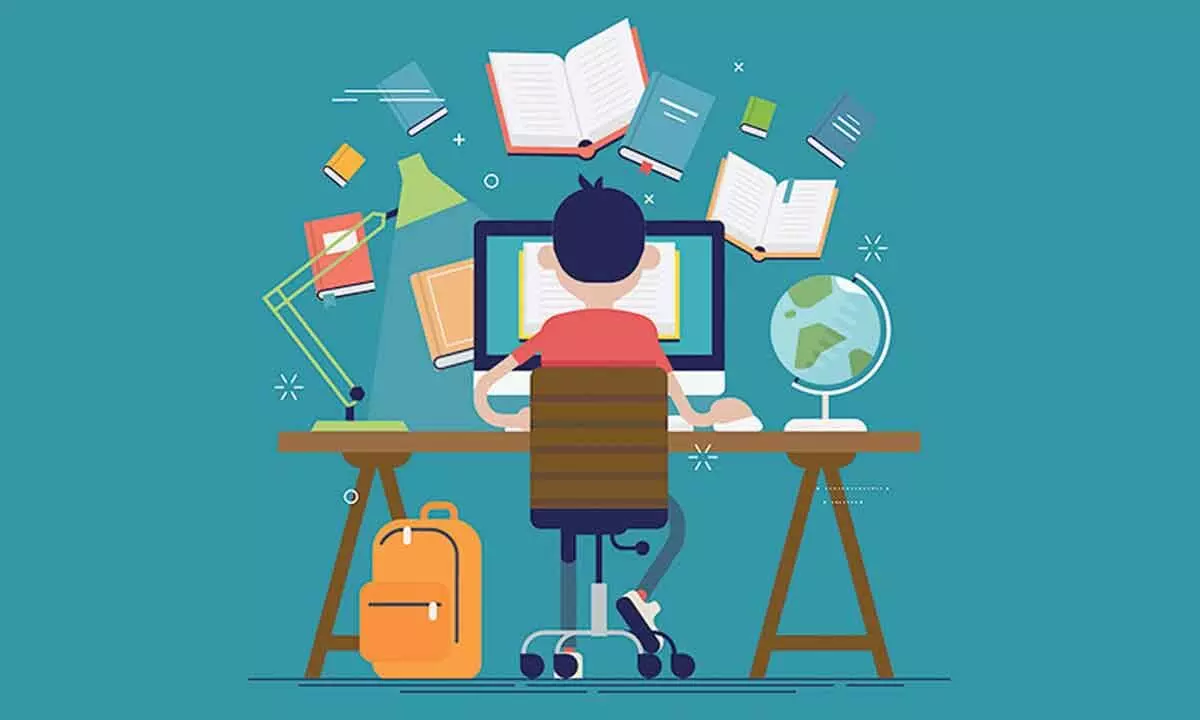Live
- Army's swift action prevented Kolkata fire from spreading: Defence Ministry
- State Police tried to murder Ravi- Union minister
- FDI flow into India from Gulf countries surges to $24.54 bn in 12 years
- BBL: McSweeney hits fiery 78 to guide Heat to thrilling win after Australia snub
- 'Exceptional case..': Delhi HC orders revision of CLAT-2025 results
- South Korea reports new avian influenza case at regional farm
- US egg prices soar to yearly high amid bird flu, holiday demand
- Ayushman Bharat proving to be boon for people in Gujarat's Kheda
- SEBI takes strict action in front running case, bars 9 entities, seizes over Rs 21 crore (Lead)
- Grand 30th Alumni Reunion at Vattam Jawahar Navodaya Vidyalaya
Just In
Bridging learning gaps in the new normal


The future of education will change as a result of this combination of physical and digital learning strategies
The Covid-19 pandemic and the subsequent lockdowns led to several children opting for online learning and classes over the past two years. But with schools slowly reopening around the country, there are several concerns that have risen amongst parents. One of these concerns includes the learning gap for their children and how schools will be able to address it. It would also be a major issue for the economy in the future as well with India's GDP taking a 3.19 per cent or $99 billion hit in 2030. So how can we address this gap?
Online-offline dilemma
One of the solutions that could be considered is to utilise technology in order to address this gap. But can classrooms also be replaced by technology? Should schools continue with online learning methods? Or will offline and online learning work in tandem?
Whilst e-learning has advantages, technology has still not been optimised for every part of the learning process. No one can also claim that online education is superior to its offline counterpart or vice versa. There are several inequalities that can play a disadvantageous role in online learning which include access to online tools, network speed/stability, utilisation, etc.
Your ability to learn independently, which is the foundation of a learning process, can be greatly improved by technology. However, these approaches mainly benefit the brightest 10% of children, leaving the other 90% of children and their parents with a lack of attention to their academic needs. Tech is not the issue, then.
In order to increase accessibility and personalization, the gap must be filled by fusing lecturing methods with online resources. One-size-fits-all educational methods, which have been the norm for almost a decade, must give way to a more in-depth and individualized teachable moment. Artificial intelligence can be used in conjunction with the principles of a professional educator to provide more effective ways to increase intellectual understanding and learning.
Blended learning must Have these 5 elements
When the idea of taking a live, online class first emerged half a decade ago, many were dubious. Today, however, the absolute majority is glued to their computers. Some basic alterations were greatly facilitated by the internet, and eventually, changes in public attitude also occurred. After the pandemic's two-year duration, teachers experienced numerous difficulties once classes resumed, including students with short attention spans, missing coursework, a lack of focus, sluggish writing abilities, and a dependence on mobile devices.
Due to this, Edtech should not be shunned in any area of life at the moment but rather should be complemented with the unique components that offline education brought. The future of education will change as a result of this combination of physical and digital learning strategies.
The learning approach should be determined by factors such as what they need, how they act, and what they can give.
The primary components of an e-learning solution are as follows:
Good learning experience
Students and teachers should be able to have both critical and enjoyable experiences with e-learning technologies.
Portable learning devices
Smartphones are more user-friendly than computers for your pupils. As a result, if you don't teach using a mobile device, your pupils are more likely to dismiss you.
Dependable programs
The success or failure of a project will be defined as the total student achievement. As a result, your web-based learning program should be dependable and well-tested to provide accurate results every time.
Safe learning environment
For informal learning to occur, a genuinely effective e-learning system should include a social dimension.
In the past several years, our nation has seen a metamorphosis. Everyone now understands that the course content, which was very conventional and concept-based in nature, will not be helpful in the future. Digital approaches can help with that because they make additional knowledge and expertise to fresher ideas readily available. Therefore, India's youth may unquestionably perform better in the classroom, boosting both their awareness and capability, by using the internet as the accelerator. This in turn also helps teachers, empowers them, and connects them to their students regardless of the location or circumstances.
(The author is the Principal at Orchids The International School)

© 2024 Hyderabad Media House Limited/The Hans India. All rights reserved. Powered by hocalwire.com






